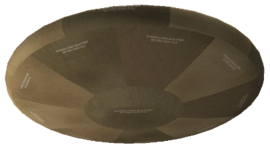Difference between revisions of "Heat Shield (10m)"
From Kerbal Space Program Wiki
| Line 1: | Line 1: | ||
{{stub}} | {{stub}} | ||
| − | + | {{:Heat Shield (1.25m)/Box}} | |
| + | |||
The '''Heat Shield (10m)''' was introduced in version [[1.1]]. Unlike other [[heat shield]]s, the 10m heat shield uses a large inflated surface instead of [[ablator]] to slow down the space craft to which it is attached.<br /> | The '''Heat Shield (10m)''' was introduced in version [[1.1]]. Unlike other [[heat shield]]s, the 10m heat shield uses a large inflated surface instead of [[ablator]] to slow down the space craft to which it is attached.<br /> | ||
When inflated, the shield has a diameter of 10m, but is 2.5m in diameter in it's uninflated state.<br /> | When inflated, the shield has a diameter of 10m, but is 2.5m in diameter in it's uninflated state.<br /> | ||
Revision as of 10:23, 23 April 2016
| Heat Shield (10m) | ||
| Heat shield by O.M.B. Demolition Enterprises | ||
| Radial size | Small | |
| Cost | (total) | 300.00 |
| (dry) | 200.00 | |
| Mass | (total) | 0.300 t |
| (dry) | 0.100 t | |
| Drag | 0.2 | |
| Max. Temp. | 3300 K | |
| Impact Tolerance | 9 m/s | |
| Research | | |
| Unlock cost | 600 | |
| Since version | 1.0 | |
| Part configuration | HeatShield1.cfg | |
| Ablator | 200 units | |
| Loss at 2000K | 0.47 units/s | |
| Ejection momentum | 100 Ns | |
| Testing Environments | ||
| On the surface | Yes | |
| In the ocean | Yes | |
| On the launchpad | Yes | |
| In the atmosphere | Yes | |
| Sub-orbital | No | |
| In an orbit | No | |
| On an escape | No | |
| Docked | No | |
| Test by staging | No | |
| Manually testable | Yes | |
| Lift generated | 0.35 | |
| Packed volume | 550 l | |
The Heat Shield (10m) was introduced in version 1.1. Unlike other heat shields, the 10m heat shield uses a large inflated surface instead of ablator to slow down the space craft to which it is attached.
When inflated, the shield has a diameter of 10m, but is 2.5m in diameter in it's uninflated state.
It costs 2400 Funds and weighs 1.5 tons. has a maximum temperature of 3,500 Kelvin. It also has an impact tolerance of 9 m/s.
Product description
| “ | Based on the design of a child's toy, this heat shield uses a set of inflable rings covered with a thermal blanket to provide a generous 10 meter heat shield for reentry and deceleration, and the aerodynamic qualities of an untethered bouncy castle. | ” |
Trivia
- A smaller scale inflatable heat shield was successfully tested by NASA in 2009.[1]
Changes
- Initial release
